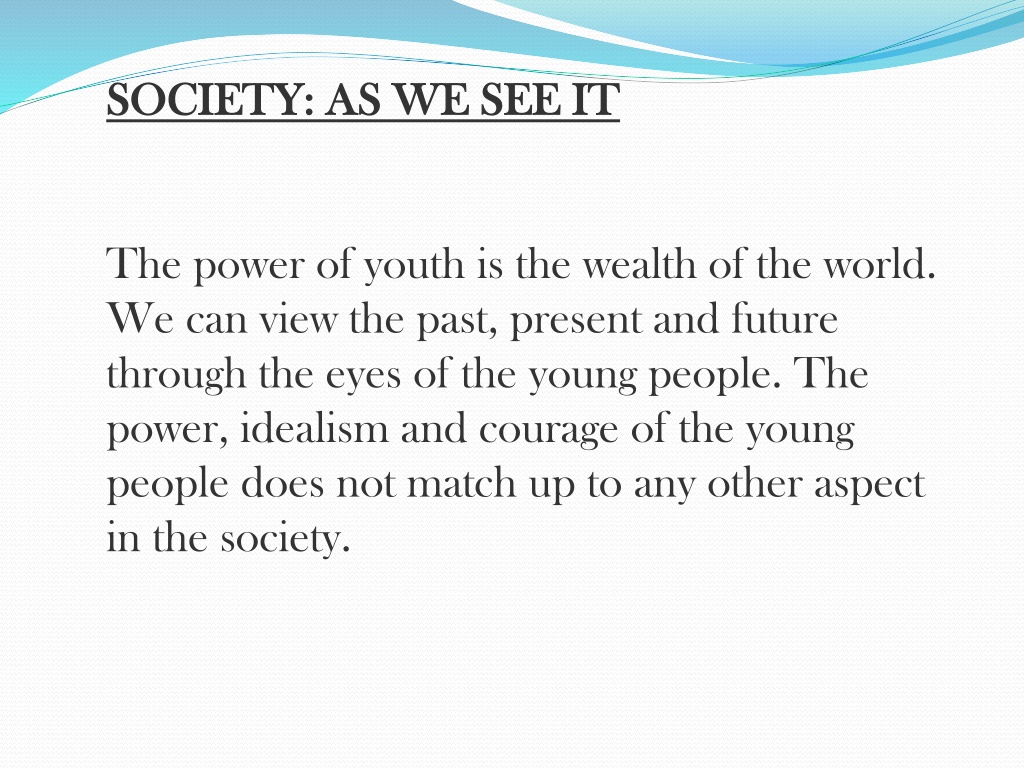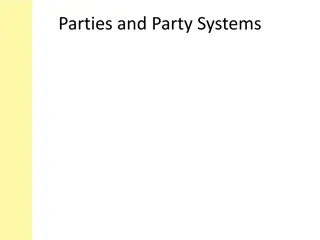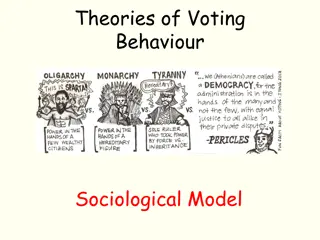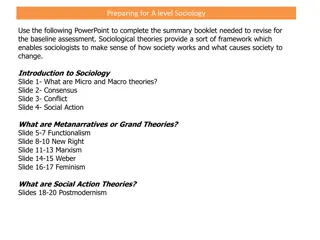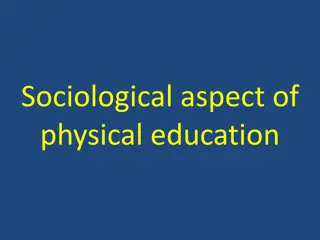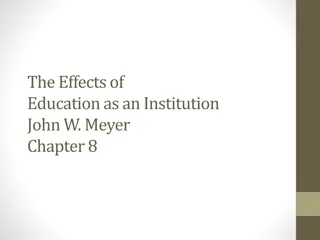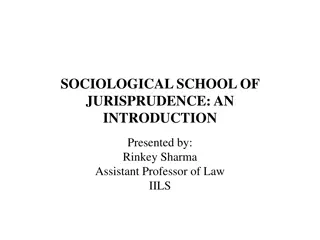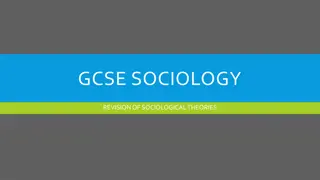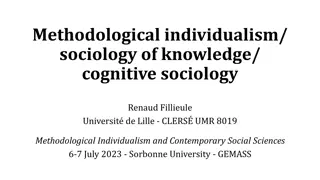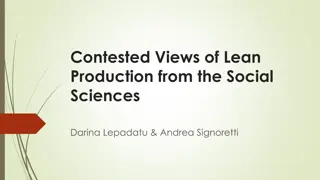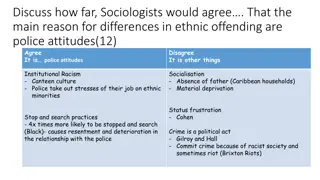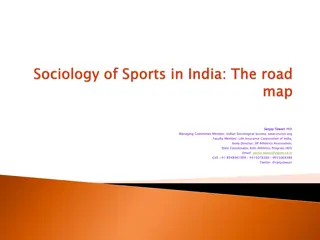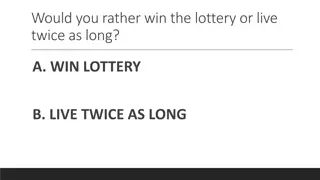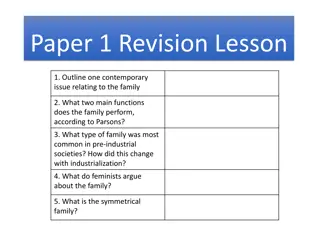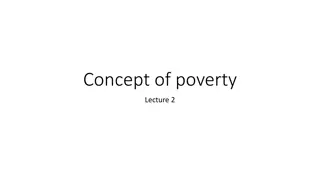Understanding Sociological Perspectives
Sociologists employ three primary theoretical perspectives to explain how society influences young people and vice versa: the symbolic interactionist perspective, the functionalist perspective, and the conflict perspective. Symbolic interactionism focuses on symbols and face-to-face interactions, while functionalism emphasizes the interdependence of society's aspects for its functioning. Critics argue that symbolic interactionism may overlook broader social issues, while functionalism has received criticism for neglecting the individual.
Download Presentation

Please find below an Image/Link to download the presentation.
The content on the website is provided AS IS for your information and personal use only. It may not be sold, licensed, or shared on other websites without obtaining consent from the author. Download presentation by click this link. If you encounter any issues during the download, it is possible that the publisher has removed the file from their server.
E N D
Presentation Transcript
SOCIETY: AS WE SEE IT SOCIETY: AS WE SEE IT The power of youth is the wealth of the world. We can view the past, present and future through the eyes of the young people. The power, idealism and courage of the young people does not match up to any other aspect in the society.
Sociologists today employ three primary theoretical perspectives: the symbolic symbolic interactionist interactionist perspective perspective, the functionalist perspective functionalist perspective, and the conflict perspective conflict perspective. These explain how society influences people or to be precise, the youth, and vice versa. Each perspective uniquely conceptualizes society, social forces, and human behavior.
Symbolic interaction-ism Use of symbols Use of symbols and face to face interactions. People attach meanings to symbols and then they act according to their subjective interpretations of those symbols. Written music Written music serves as an example. The black dots and lines become more than mere marks on the page; they refer to notes organized in such a way as to make musical sense. Symbols may include wedding bands, a white bridal dress, a wedding cake and flowers and music. (students own examples)
Criticism: Critics claim that symbolic interaction-ism neglects level of social interpretation the big picture. neglects the macro big picture. In other words, symbolic interactionists may miss the larger issues of society by focusing too closely on the trees (for example, the size of the diamond in the wedding ring) rather than the forest (for example, the quality of the marriage). Thus, faulty communication can result from differences in the perception of the same events and symbols.
The Functional perspective (functionalism) Each aspect of society is interdependent and contributes to society's functioning as a whole.(parts of the society works as a whole for the parts of the society works as a whole for the best interest of the society). best interest of the society). During a financial recession with its high rates of unemployment and inflation, social programs are trimmed or cut. Schools offer fewer programs. Families tighten their budgets. And a new social order, stability, and productivity occur. stability, and productivity occur. new social order, Govt----schools------education----employment-----tax givers(becomes productive) Functionalists believe that people work in cohesion that they can achieve what is best for the society. work in cohesion in the society so
Critics say Functionalism has received criticism for neglecting the individual and stresses more on institutions individual and stresses more on institutions. neglecting the Functionalism does not encourage people to take an active role does not encourage people to take an active role in changing their social environment in changing their social environment, even when such change may benefit them. Instead, functionalism sees active social change as undesirable because the various parts of society will compensate naturally for any problems that may arise.
The conflict perspective The conflict perspective conflict perspective focuses on the negative, conflicted, and ever changing nature of society. Unlike functionalists who defend the status quo, avoid social change, and believe people cooperate to effect social order, conflict theorists challenge the status quo, encourage social change (even when this challenge the status quo, encourage social change (even when this means social revolution), and believe rich and powerful people force means social revolution), and believe rich and powerful people force social order on the poor and the weak. social order on the poor and the weak. conflict theorists For example For example, conflict theorists view the relationship between a housing complex owner and a tenant is based mainly on conflict instead of balance and harmony, even though there may be more harmony than conflict. .
Critical viewpoint: Critics of the conflict perspective point to its overly negative view of society. of society. negative view Conflict theorists tend to take side with the people that lack social power. Critics say that this violates scientific objectivity violates scientific objectivity.
Societal Themes in Indian Society India offers diversities in ethnic, linguistic, regional, economic, religious, class, and caste groups. These are also permeated with immense urban-rural differences and gender distinctions. Differences between north India and south India are particularly significant, especially in systems of kinship and marriage. Adding further variety to contemporary Indian culture are rapidly occurring changes affecting various regions and socioeconomic groups in disparate ways. Yet, amid the complexities of Indian life, widely accepted cultural themes enhance social harmony and order.
Hierarchy India is a hierarchical society. Whether in north India or south India, Hindu or Muslim, urban or village, virtually all things, people, and social groups are ranked according to various essential qualities. Individuals are also ranked example, some powerful people sit confidently on chairs, while common man come before them to make requests, either standing or squatting not presuming to sit beside a man of high status as an equal. ranked according to their wealth and power wealth and power. For Hierarchy Hierarchy plays an important role within families recognize age differences, with younger siblings addressing older siblings by respectful terms rather than by name. within families too, siblings,
Purity and pollution Many status differences in Indian society are expressed in terms of ritual purity and pollution. Generally, high status with pollution. with pollution. high status is associated with purity purity and low status low status Some kinds of purity are inherent purity are inherent; for example, a member of a high-ranking Brahmin is born with more inherent purity than someone born into a low-ranking caste. Other kinds of purity are more transitory purity are more transitory for example, a Brahmin who has just taken a bath is more ritually pure than a Brahmin who has not bathed for a day.
Social Interdependence One of the great themes pervading Indian life is social interdependence. People are born into groups families, clans, sub-castes, castes, and religious communities and feel a deep sense of inseparability from these groups. People are deeply involved with others, and for many, the greatest fear is the possibility of being left alone, without social support. possibility of being left alone, without social support. greatest fear is the When a girl brings water home from the well in pots on her head, someone helps her unload the pots. A student hopes that an influential relative or friend can facilitate his college admission. Finally, a person facing death expects that relatives will conduct the proper a person facing death expects that relatives will conduct the proper funeral rites ensuring his own smooth passage to the next stage of existence funeral rites ensuring his own smooth passage to the next stage of existence and reaffirming social ties among mourners. and reaffirming social ties among mourners.
Family ideals The joint family is highly valued, ideally consisting of several generations residing, working, eating, and worshiping together. Even in rapidly modernizing India, the traditional joint household remains for most Indians the primary social force, in both ideal and practice. Large families Large families tend to be flexible especially for more than two-thirds of Indians who are involved in agriculture agriculture as cooperating kin help provide mutual economic security The joint family is also common in cities crucial to obtaining employment or financial assistance employment or financial assistance. Many prominent families, such as the Tatas, Birlas, and Ambanis, retain joint family arrangements as they cooperate in controlling major financial empires. financial empires. flexible and well suited to Indian life, mutual economic security. cities, where kinship ties are often controlling major
Veiling and the Seclusion of Women A significant aspect of Indian family life is purdah (from Hindi parda, or curtain ), or the veiling and seclusion of women. In most parts of northern and central India, particularly in rural areas, Hindu and Muslim women follow complex rules of veiling the body and avoidance of public appearance, especially before relatives linked by marriage and before strange men. by marriage and before strange men. especially before relatives linked Purdah practices are linked to patterns of authority and harmony within the family. Hindu and Muslim purdah observances differ in certain key ways, but family family honor honor and prestige are essential to the various forms of various forms of purdah purdah but as education and employment opportunities for women increase, veiling has all but disappeared in progressive circles. and prestige are essential to the
Rural life Agriculture Not isolated socially or economically Most villages include a multiplicity of economic, caste, kinship, occupational, and even religious groups linked vertically within each settlement Dissent and competitiveness seem to have increased in many parts of rural India as a result of the expanding involvement of villagers with the wider world via travel, work, education, and television, and increased pressure on land and resources as village populations grow.
Urban life The acceleration of urbanization is profoundly affecting the transformation of Indian society. Slightly more than one-quarter of the country s population is urban. Mumbai (Bombay) is currently the sixth largest urban area in the world at 18 million, and Kolkata (Calcutta) ranks fourteenth at 13 million. Densely populated, polluted. More educational and employment opportunities available. Social revolutions, too, receive the support of urban visionaries, such Social revolutions, too, receive the support of urban visionaries, such as those shaping the growing women s movement. Largely led by as those shaping the growing women s movement. Largely led by educated urban women, the movement seeks gender justice on a wide educated urban women, the movement seeks gender justice on a wide variety of issues variety of issues
Strengths Seeking solutions to different problems Bringing together widely disparate groups in structured efforts to benefit the wider society. Encouraging harmony among people with divergent interests, knowing that close relatives and friends can rely upon each other. Allocating different tasks to those with different skill. Striving to do what is morally right in the eyes of the community.
